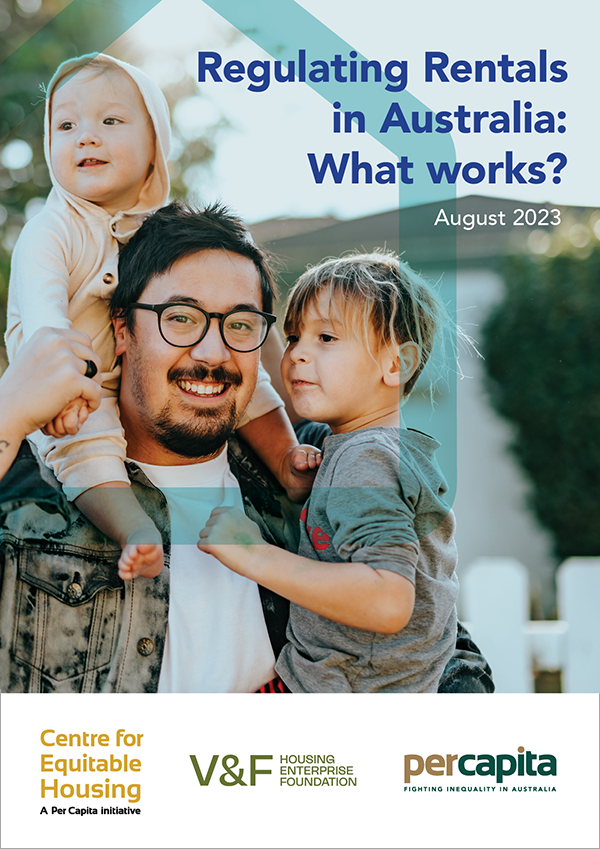With almost a third of households now renting, a spotlight has been thrown upon the poor conditions in many parts of Australia’s rental market: short tenures, an absence of quality standards, sudden unpredictable spikes in rental prices and a lack of affordable properties are pushing too many Australians into housing stress and putting them at risk of homelessness.
This paper seeks to shed some light on a heated debate. It examines the data to establish if there is, indeed, a rental crisis in Australia, and surveys local and international research to determine what would work to improve the experience of renting a home in the Australian market.
We start from a simple position: that the goal of government housing policy should be to ensure that everyone in our wealthy country has a safe, secure, affordable and comfortable home.
We find that, despite the increasingly rancorous political debate, there is no evidence of a rental price crisis at the market median: that is, the rents being paid by middle and higher income households as a proportion of their income is roughly consistent with the historical average.
While there have been significant spikes in asking rents over the last year, the actual rents paid by sitting tenants have increased much less sharply, and a quarter of tenants have seen no increase at all in the last year.
What is undeniable, and not news to anyone working in housing and homelessness services across the country, is that there is a genuine crisis for low-income households in Australia’s rental market, one that has been brewing for over 20 years. While the average proportion of income paid as rent by middle-income households is around 30%, the definition by which that threshold denotes rental stress applies only to households in the bottom 40% of income distribution: and they are paying more than half of their income just to put a roof over their heads.
There is an urgent need to reform Australia’s residential rental property system. Tenants here enjoy far less security in their homes than do renters in comparable countries. By international standards, we have low levels of protection for tenants from eviction, and inadequate, ad hoc regulations for the quality and maintenance of rental properties. The research clearly demonstrates that Australia’s state and territory governments must overhaul rental regulations to give more power to tenants, and reform planning systems to provide more affordable and appropriate housing where people need and want to live.
We find that a significant cause of rental insecurity in Australia is the structure of our residential investment sector. Australia’s housing market is dominated by small-scale, hobby landlords – so-called “mum and dad” investors, who are often highly leveraged and unable to properly manage or service the homes they rent, particularly at the lower end of the market.
This is in large part driven by the investor tax concessions that encourage speculation on property by ordinary income earners, vastly reducing the real cost of investment and fostering a market in which landlords eschew positive rental yields in pursuit of a short-term, heavily tax discounted capital gain.
The research contains some surprising findings: there is not, for example, an aggregate lack of supply in the housing market. Australia builds more homes per capita annually than do most comparable developed countries. There is plenty of market-rate housing available across the country; the problem is a severe and compounding lack of quality social and affordable housing for those at the bottom of the income scale.
What is also clear is that while median rents have remained relatively stable on aggregate, many individuals are suffering very high and unpredictable rent increases. This unpredictability of when and by how rent increases occur is causing significant community concern. Given the nature of the current political debate, we investigate options for rent controls, examining the literature and evidence from markets in which rental price regulations have been implemented.
We find that first generation rent control, or a “rent freeze”, would be a poor response to the real challenges facing Australia’s housing system, almost certainly making the problem worse for those in real housing stress. Freezing rents has been shown to reduce supply at the lower end of the market, as investors shift to higher-yield property development and withdraw more affordable properties from the market altogether.
The inherent problems with freezing rents would be compounded by Australia’s relatively lax tenancy regulations. Poor regulation of short-term rentals in many jurisdictions, and the allowing of no-fault evictions in various regions would likely see landlords flee the residential market or terminate leases to reset rents ahead of a freeze.
Our research finds that some form of second or third generation rent control, essentially stabilisation of rental increases, is feasible in Australia, and may reduce the prevalence of rent spikes and tenant insecurity. However, these would need to be carefully designed for the conditions of the local market in order to ensure that adverse consequences, most likely to hit those already in housing stress, are avoided.
We conclude that, in order for the real problems in Australia’s housing market to be addressed, we require a bold and ambitious national policy that is focussed on significant government investment, and incentives for the private sector, to build more social and affordable homes. Alongside this investment must be a nationally coordinated housing policy process, and a body to oversee the implementation of multiple policy interventions in the housing market.
This must include addressing distortive tax concessions that create such instability in the investor class, an increase of market-priced housing in inner and middle suburbs, improved rights for renters, reform of the current system of Commonwealth Rent Assistance, and a long-term commitment to providing non-market – public and community – housing by all levels of government.


